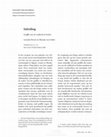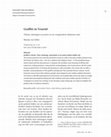Books by Maartje van Gelder

Popular Politics in an Aristocratic Republic explores the different aspects of political actions ... more Popular Politics in an Aristocratic Republic explores the different aspects of political actions and experiences in late medieval and early modern Venice.
The book challenges the idea that the city of Venice knew no political conflict and social contestation during the medieval and early modern periods. By examining popular politics in Venice as a range of acts of contestation and of constructive popular political participation, it contributes to the broader debate about premodern politics. The volume begins in the late fourteenth century, when the demographical and social changes resulting from the Black Death facilitated popular challenges to the ruling class’s power, and finishes in the late eighteenth century, when the French invasion brought an end to the Venetian Republic. It innovates Venetian studies by considering how ordinary Venetians were involved in politics, and how popular politics and contestation manifested themselves in this densely populated and diverse city. Together the chapters propose a more nuanced notion of political interactions and highlight the role that ordinary people played in shaping the city’s political configuration, as well as how the authorities monitored and punished contestation.
Popular Politics in an Aristocratic Republic combines recent historiographical approaches to classic themes from political, social, economic, and religious Venetian history with contributions on gender, migration, and urban space. The volume will be essential reading for students of Venetian history, medieval and early modern Italy and Europe, political and social history.
Graffiti van de oudheid tot heden

Trading Places: The Netherlandish Merchants in Early Modern Venice
This book deals with the Netherlandish merchant community in sixteenth- and seventeenth-century V... more This book deals with the Netherlandish merchant community in sixteenth- and seventeenth-century Venice. It examines the merchants’ commercial activities, their social and communal relations, as well as their interaction with the Venetian state, which was accustomed to protect its own trade. The Netherlandish merchants in Venice, as part of an extensive international trading network, were ideally placed to connect Mediterranean and Atlantic commerce. They quickly became the most important group of foreign merchants in the city at a time of rapid economic changes. Drawing on a wide variety of primary sources, this book shows how these immigrant traders used their strong commercial position to secure a place in Venice. It demonstrates how the changing balance of international commerce affected early modern Venetian society.
Papers by Maartje van Gelder

Past & Present, 2022
This article studies the intertwined processes of popular protest and archival suppression in ear... more This article studies the intertwined processes of popular protest and archival suppression in early modern Venice. It concentrates on a cycle of contention extending over several months in 1569, including a labour protest that started among the workers of the state shipyard and turned into a large revolt, anonymous placards and food riots. Such was the extent of the unrest that a major explosion in the shipyard raised suspicion of sabotage. Eventually, the government had to capitulate to the workers’ demands. This cycle of protests in Venice, a city normally renowned for peace and concord, has left minimal traces in the official records: the government tried to suppress the protests not only in practice but also on paper. It carried out convictions in secret, obliterated the revolt from its archives, buried any mention of protest under countless other records, and elided dissent from published histories. By using a variety of non-governmental sources, it is possible to investigate h...

Tijdschrift voor Geschiedenis, 2018
Zie voor de spanning tussen graffiti op kunstwerken en de praktijk van restauratoren o.a. Véroniq... more Zie voor de spanning tussen graffiti op kunstwerken en de praktijk van restauratoren o.a. Véronique Plesch, 'Destruction or preservation? The meaning of graffiti at religious sites' in: Virginia Chieffo Raguin ed. Art, piety and destruction in European religion, 1500-1700 (Aldershot 2010) 137-172 en Charlotte Guichard, Graffitis. Inscrire son nom à Rome XVIe-XIXe siècle (Parijs 2014). 4 Rafael Schacter, The world atlas of street art and graffiti (Kensington, NSW 2013) 7. Zie bijvoorbeeld ook Craig Castleman, Getting up. Subway graffiti in New York (Cambridge Ma. 1982); Joe Austin, Taking the train. How graffiti art became an urban crisis in New York City (New York 2001); Roger Gastman en Caleb Neelon, The history of American graffiti (Londen 2006) en de inleiding op Troy Lovata en Elizabeth Olton ed., Understanding graffiti. Multidisciplinary studies from prehistory to the present (Walnut Creek 2015).

Occasions of State, 2018
This series, in association with the Society for European Festivals Research, builds on the curre... more This series, in association with the Society for European Festivals Research, builds on the current surge of interest in the circumstances of European Festivals-their political, religious, social, economie and cultural implications as well as the detailed analysis of their performance (including ephemeral architecture, scenography, scripts, music and soundscape, dance, costumes, processions and fireworks) in both indoor and outdoor locations. Festivals were interdisciplinary and, on occasion, international in scope. They drew on a rich classica! heritage and developed a shared pan-European iconography as well as exploiting regional and site-specific features. They played an important part in local polities and the local economy, as well as international negotiations and the conscious presentation of power, sophistication and national identity. The series, including both essay collections and monographs, seeks to analyse the characteristics of individual festivals as well as to explore generic themes. lt draws on a wealth of archival documentary evidence, alongside the resources of galleries and museums, to study the historical, literary, performance and material culture of these extravagant occasions of state.

Changing tack: the versatile allegiances of Daniel Nijs. A Netherlandish merchant and information broker in early modern Venice
Dutch Crossing, 2006
Abstract This article traces the often conflicting roles and changing fortunes of Daniel Nijs (15... more Abstract This article traces the often conflicting roles and changing fortunes of Daniel Nijs (1572–1647) in order to investigate the strategies used by immigrant merchants operating in early-modern Europe. Born in Germany as the son of religious exiles from the Southern Netherlands, Nijs moved to Venice to become a trader. A renowned collector himself, he was instrumental in the sale of the Mantuan Gonzaga art-collection to Charles I. But this was only one of his many ventures: besides his activities as an international merchant, Nijs also controlled one of Venice's customhouses, acted as post-master between the Serenissima and the Dutch Republic and became consul for Sweden. In addition, he financially contributed to Venice's war efforts against the Austrian Habsburgs and opened his Venetian home to Calvinist services. He embarked on yet another course of action when he was recruited as a spy by the Spanish ambassador, preparing a conspiracy against the Venetian Republic. This entrepreneur constantly juggled different allegiances, showing a remarkable strategic adaptability in the complex arena of early-modern international trade, politics, religion and culture. His access to goods, information and artefacts made him the epitome of an intermediary. An analysis of his professional practices and ramified network of contacts will show how the early-modern immigrant merchant manoeuvred between conflicting and malleable national, cultural and religious identities.
Mélanges de l’École française de Rome. Italie et Méditerranée, 2013
Avertissement Le contenu de ce site relève de la législation française sur la propriété intellect... more Avertissement Le contenu de ce site relève de la législation française sur la propriété intellectuelle et est la propriété exclusive de l'éditeur. Les oeuvres figurant sur ce site peuvent être consultées et reproduites sur un support papier ou numérique sous réserve qu'elles soient strictement réservées à un usage soit personnel, soit scientifique ou pédagogique excluant toute exploitation commerciale. La reproduction devra obligatoirement mentionner l'éditeur, le nom de la revue, l'auteur et la référence du document. Toute autre reproduction est interdite sauf accord préalable de l'éditeur, en dehors des cas prévus par la législation en vigueur en France. Revues.org est un portail de revues en sciences humaines et sociales développé par le Cléo, Centre pour l'édition électronique ouverte (CNRS, EHESS, UP, UAPV).
Migration and Membership Regimes in Global and Historical Perspective, 2013
Map 1. Venice and its territories in the sixteenth century. (©Maartje van Gelder) favouring forei... more Map 1. Venice and its territories in the sixteenth century. (©Maartje van Gelder) favouring foreign traders? 143
Acquiring Artistic Expertise: The Agent Daniel Nijs And His Contacts With Artists In Venice
Double Agents
Garcia de Yllan's career as a provider of credit to the King of Spain is not an isolated case... more Garcia de Yllan's career as a provider of credit to the King of Spain is not an isolated case; it is illustrative of a number of Portuguese, Portuguese-Jewish and other entrepreneurs who did business with and for the Spanish monarchy in the seventeenth century. Garcia de Yllan Barraza's life and business do not stand in isolation. There are specific and unmistakable differences between the enterprises of other Portuguese traders and his career and activities for the Spanish crown and the Swedish queen, but there are also ines- capable similarities to the businesses of others like him in the king's service—men such as Manuel Cortizos Villasante, Francisco Lopez Franco y Feo and Fernando de Montesinos Tellez. Keywords:Garcia De Yllan; Spain
Journal of Early Modern History, 2015
This article explores the ways in which Dutch converts to Islam acted as informants, intermediari... more This article explores the ways in which Dutch converts to Islam acted as informants, intermediaries and at times even informal diplomats for the Dutch Republic, a newcomer to Mediterranean trade and diplomacy. It asks how these renegades, who often occupied high ranks in the North African corsairing fleets and local positions of power, facilitated and shaped Dutch-North African relations. The article explores the renegades’ diplomatic services, follows them as they (re)establish contact with the Dutch Republic, and analyzes how they fashioned themselves as cross-confessional mediators. Far from being marginal figures caught in the dichotomy of a Christian past and a Muslim present, Dutch renegades operated as part of a continuum that encompassed both the Islamic Mediterranean and the Dutch Republic.

Journal of Early Modern History, 2015
This special issue, an exercise in integrated Mediterranean history through the lens of diplomacy... more This special issue, an exercise in integrated Mediterranean history through the lens of diplomacy, demonstrates that diplomatic genres and practices associated with a European political and cultural tradition, on the one hand, or an Islamic tradition, on the other, were not produced in isolation but attained meaning through the process of mediation and negotiation among intermediaries of different confessional and social backgrounds. Building on the “new diplomatic history,” the essays focus on non-elite (e.g. Christian slaves, renegades, Jewish doctors, Moriscos) and less commonly studied (mid- and high-ranking Muslim officials) intermediaries in Mediterranean cross-confessional diplomacy. The issue argues that the early modern period witnessed a relative balance of power among Muslim- and Christian-ruled polities: negotiations entailed not only principles of reciprocity, parity, and commensurability, but these were actually enforceable in practice. This challenges the notion of Eu...
Tijdschrift voor Geschiedenis, 2012
Algemeen Karel Davids en Marjolein 't Hart ed., De wereld & Nederland. Een sociale en economische... more Algemeen Karel Davids en Marjolein 't Hart ed., De wereld & Nederland. Een sociale en economische geschiedenis van de laatste duizend jaar Jan Luiten van Zanden, The long road to the Industrial Revolution. The European economy in a global perspective, 1000-1800; Paolo Malanima, Pre-modern European economy. One thousand years (10th-19th centuries) Robert Muchembled, A history of violence. From the end of the Middle Ages to the present Paul Van Damme en Stijn Van de Perre, Zonder woorden? Een geschiedenis van België in spotprenten Daantje Meuwissen, Gekoesterde traditie. De portretreeks met de landcommandeurs van de Utrechtse Balije van de Ridderlijke Duitsche Orde Evert Peeters en Leen Van Molle ed., Beyond pleasure. Cultures of modern asceticism
Tijdschrift voor Geschiedenis, 2013

The Journal of Modern History, 2018
On Friday, April 7, 1595, a solemn procession accompanied the body of Pasquale Cicogna, the eight... more On Friday, April 7, 1595, a solemn procession accompanied the body of Pasquale Cicogna, the eighty-sixth doge of the Venetian Republic, to his final resting place. 1 Ducal funerary processions traditionally involved more than a thousand participants, including Venetian magistrates, ecclesiastics, representatives of the confraternities, and foreign diplomats; many thousands of spectators looked on. 2 A guard of Arsenalotti, workers from the state shipyard, carried Doge Cicogna's bier out of the Ducal Palace and into Piazza San Marco, the political and religious heart of the city and as such the central space for governmental ritual. 3 Ducal funeral ceremonies were supposed to be a formal celebration of republican values, underlining the durability of the Venetian state despite the mortality of its doges. But the moment Cicogna's body left the palace the procession was interrupted. In the palace courtyard, in front of the members of the Signoria, the republic's highest executive council, 4 "all the boys and common people shouted 'Viva, viva, Marino Grimani!'" in a show of enthusiasm for one of Cicogna's

Past & Present, 2022
On the afternoon of Saturday, 12 March 1569, hundreds of workers stormed out of the Venetian stat... more On the afternoon of Saturday, 12 March 1569, hundreds of workers stormed out of the Venetian state shipyard, or Arsenal, shouting and brandishing hatchets and hammers. Angered by a salary cut announced that morning, they invaded the government palace, threatened their patrician rulers, and refused to leave until their demands were accepted. Their revolt effectively obstructed the state's functioning and, since the shipyard workers had a dual function as palace guards, posed a serious threat. While the workers occupied the hall of the College, the Republic's steering committee, hundreds of toga-clad patricians gathered for the scheduled meeting of the Senate. Unable to access the palace, younger senators prepared to liberate it by force. 1 An armed assault on the seat of government, workers threatening the highestranking patricians, and senators itching for a fight with commoners: little here conforms to the standard image of Venice as the 'most serene one', an exceptionally stable city state, immune to political contestation-and indeed in the records produced by that state, this image remains intact. Nothing described above is recorded in the government archives. On paper, this was a day like any other in the * We thank Ilaria Favretto, Michiel van Groesen, Kat Hill, Vittorio Mandelli and Claire Judde de Larivière for their comments and suggestions as well as participants
The People's Prince. Popular Politics in Early Modern Venice

Graffiti in Venice. Texts, drawings, and posters in an early modern Italian city This article exa... more Graffiti in Venice. Texts, drawings, and posters in an early modern Italian city This article examines how and why Venetians wrote on walls in the early modern period. From the Piazza San Marco area – the city's political and religious heart – to the peripheral quarantine island and the ducal prisons, it analyses the locations and meaning of official and subversive writing practices, using archival, archaeological, and visual sources. By first examining accepted forms of writing and drawing on walls and pillars, the article aims to offer a broader contextualization of the graffiti and placards that attacked those in power. Social historians have shown that ordinary people were integral to pre-modern political dynamics. Yet Venice is still often portrayed as la Serenissima, an exceptionally serene city-state, an image constructed and projected during the late medieval and early modern period. A further investigation of subversive writings in the Venetian urban landscape can help to establish the political role of ordinary Venetians.
Introduction to special issue of the Journal of Early Modern History 19, 2-3 (2015), 93-105
This paper explores the ways in which Dutch converts to Islam acted as informants, intermediaries... more This paper explores the ways in which Dutch converts to Islam acted as informants, intermediaries and at times even informal diplomats for the Dutch Republic, a newcomer to Mediterranean trade and diplomacy. It asks how these renegades, who often occupied high ranks in the North African corsairing fleets and local positions of power, facilitated and shaped Dutch-North African relations. The article explores the renegades’ diplomatic services, follows them as they (re)establish contact with the Dutch Republic, and analyzes how they fashioned themselves as cross-confessional mediators. Far from being marginal figures caught in the dichotomy of a Christian past and a Muslim present, Dutch renegades operated as part of a continuum that encompassed both the Islamic Mediterranean and the Dutch Republic.
Uploads
Books by Maartje van Gelder
The book challenges the idea that the city of Venice knew no political conflict and social contestation during the medieval and early modern periods. By examining popular politics in Venice as a range of acts of contestation and of constructive popular political participation, it contributes to the broader debate about premodern politics. The volume begins in the late fourteenth century, when the demographical and social changes resulting from the Black Death facilitated popular challenges to the ruling class’s power, and finishes in the late eighteenth century, when the French invasion brought an end to the Venetian Republic. It innovates Venetian studies by considering how ordinary Venetians were involved in politics, and how popular politics and contestation manifested themselves in this densely populated and diverse city. Together the chapters propose a more nuanced notion of political interactions and highlight the role that ordinary people played in shaping the city’s political configuration, as well as how the authorities monitored and punished contestation.
Popular Politics in an Aristocratic Republic combines recent historiographical approaches to classic themes from political, social, economic, and religious Venetian history with contributions on gender, migration, and urban space. The volume will be essential reading for students of Venetian history, medieval and early modern Italy and Europe, political and social history.
Papers by Maartje van Gelder
The book challenges the idea that the city of Venice knew no political conflict and social contestation during the medieval and early modern periods. By examining popular politics in Venice as a range of acts of contestation and of constructive popular political participation, it contributes to the broader debate about premodern politics. The volume begins in the late fourteenth century, when the demographical and social changes resulting from the Black Death facilitated popular challenges to the ruling class’s power, and finishes in the late eighteenth century, when the French invasion brought an end to the Venetian Republic. It innovates Venetian studies by considering how ordinary Venetians were involved in politics, and how popular politics and contestation manifested themselves in this densely populated and diverse city. Together the chapters propose a more nuanced notion of political interactions and highlight the role that ordinary people played in shaping the city’s political configuration, as well as how the authorities monitored and punished contestation.
Popular Politics in an Aristocratic Republic combines recent historiographical approaches to classic themes from political, social, economic, and religious Venetian history with contributions on gender, migration, and urban space. The volume will be essential reading for students of Venetian history, medieval and early modern Italy and Europe, political and social history.
We associate tattoos and graffiti automatically with contemporary urban life and its inhabitants. But both practices date back much further than is generally thought, even by scholars. In cities all over the world and through the ages, we find temporary signs in a wide array of public places and on objects, such as outer and inner walls of buildings, monuments, ceramics, rocks and trees. Human bodies and clothing have also often been the carrier of such ephemeral but public messages.
This international conference - organised by the Amsterdam Centre for Urban History - sets out to explore the potential of graffiti and other transient writings for the reconstruction of urban history through the ages. Who were the authors and who the viewers? How do these writings interact with their support (walls, human bodies)? What new perspectives do they offer to examine the agency of, and communication between, different groups of the urban population? What happens to our understanding of premodern history and writing when we expand our modern assumptions of what constitutes written expression? And when we move beyond seeing graffiti on paintings, statues and monumental buildings as acts of vandalism, what happens to the way we practice history, art history and architectural history?